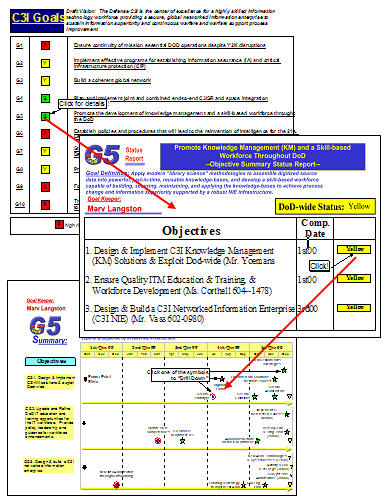Defining Project Goals and Objectives
By contributing author and project management expert Tom Mochal

Create a hierarchy of schedules from goals to objectives to action items. Use the Internet Publishing Wizard to generate web pages with drill-down.
Goals and Objectives
Goals and objectives are statements that describe what the project will accomplish, or the business value the project will achieve.
Goals are high level statements that provide overall context for what the project is trying to achieve, and should align to business goals.
Objectives are lower level statements that describe the specific, tangible products and deliverables that the project will deliver.
The definition of goals and objectives is more of an art than a science, and it can be difficult to define them and align them correctly.
Goals
Goals are high-level statements that provide the overall context for what the project is trying to accomplish. Let’s look at an example and some of the characteristics of a goal statement. One of the goals of a project might be to “increase the overall satisfaction levels for clients calling to the company helpdesk with support needs”.
- Because the goal is at a high-level, it may take more than one project to achieve. In the above example, for instance, there may be a technology component to increasing client satisfaction. There may also be new procedures, new training classes, reorganization of the helpdesk department and modification of the company rewards system. It may take many projects over a long period of time to achieve the goal.
- The goal should reference the business benefit in terms of cost, speed and / or quality. In this example, the focus is on quality of service. Even if the project is not directly in support of the business, there should be an indirect tie. For instance, an IT infrastructure project to install new web servers may ultimately allow faster client response, better price performance, or other business benefit. If there is no business value to the project, the project should not be started.
- Generally, non-measurable: If you can measure the achievement of your goal, it is probably at too low a level and is probably more of an objective.
- If your goal is not achievable through any combination of projects, it is probably written at too high a level. In the above example, you could envision one or more projects that could end up achieving a higher level of client satisfaction. A goal statement that says you are trying to achieve a perfect client experience is not possible with any combination of projects. It may instead be a vision statement, which is a higher level statement showing direction and aspiration, but which may never actually be achieved.
It is important to understand business and project goal statements, even though goals are not a part of the TenStep Project Definition. Goals are most important from a business perspective. The project manager needs to understand the business goals that the project is trying to contribute to. However, you do not need to define specific project goals. On the other hand, objectives definitely are important.
Objectives
Objectives are concrete statements describing what the project is trying to achieve. The objective should be written at a lower level, so that it can be evaluated at the conclusion of a project to see whether it was achieved or not. Goal statements are designed to be vague. Objectives should not be vague. A well-worded objective will be Specific, Measurable, Attainable/Achievable, Realistic and Time-bound (SMART).
An example of an objective statement might be to “upgrade the helpdesk telephone system by December 31 to achieve average client wait times of no more than two minutes”.
- Note that the objective is much more concrete and specific than the goal statement.
- The objective is measurable in terms of the average client wait times the new phone system is trying to achieve.
- We must assume that the objective is achievable and realistic.
- The objective is time-bound, and should be completed by December 31.
Objectives should refer to the deliverables of the project. In this case, it refers to the upgrade of the telephone system. If you cannot determine what deliverables are being created to achieve the objective, then the objective may be written at too high a level. On the other hand, if an objective describes the characteristics of the deliverables, they are written at too low a level. If they describe the features and functions, they are requirements, not objectives.
About the Author
Tom Mochal is President of TenStep, Inc., a methodology and project management consulting and training firm. He has previously worked for Geac, Coca-Cola, Eastman Kodak, and Cap Gemini Ernst & Young. Tom has developed a project management methodology called TenStep, a PMO framework called PMOStep and an application support framework called SupportStep.
